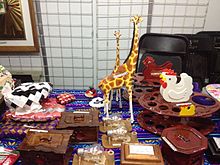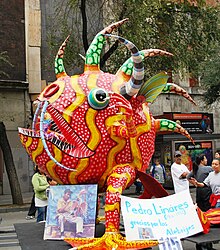
Alebrijes are brightly colored Mexican folk art sculptures of fantastical (fantasy/mythical) creatures.

The Museo de Arte Popular is a museum in Mexico City, Mexico that promotes and preserves part of the Mexican handcrafts and folk art. Located in the historic center of Mexico City in an old fire house, the museum has a collection which includes textiles, pottery, glass, piñatas, alebrijes, furniture and much more. However, the museum is best known as the sponsor of the yearly, Noche de Alebrijes parade in which the fantastical creatures are constructed on a monumental scale and then paraded from the main plaza or Zocalo to the Angel of Independence monument, competing for prizes.

Museo Universitario de Artes Populares María Teresa Pomar is a museum dedicated to Mexico's handcrafts and folk art tradition, called “artesanía.” It is part of the University of Colima in the city of Colima, founded by artesanía collector and promoter María Terea Pomar. It contains one of the most important collections of its type in Mexico, covering traditions from around the country as well as the artesanía and traditions of the state of Colima.

Cartonería or papier-mâché sculptures are a traditional handcraft in Mexico. The papier-mâché works are also called "carton piedra" for the rigidness of the final product. These sculptures today are generally made for certain yearly celebrations, especially for the Burning of Judas during Holy Week and various decorative items for Day of the Dead. However, they also include piñatas, mojigangas, masks, dolls and more made for various other occasions. There is also a significant market for collectors as well. Papier-mâché was introduced into Mexico during the colonial period, originally to make items for church. Since then, the craft has developed, especially in central Mexico. In the 20th century, the creation of works by Mexico City artisans Pedro Linares and Carmen Caballo Sevilla were recognized as works of art with patrons such as Diego Rivera. The craft has become less popular with more recent generations, but various government and cultural institutions work to preserve it.
The Linares family in Mexico City are among the best known practitioners of a craft known as “cartonería” or the use of papier-mâché to create hard sculptured objects. They have an international reputation for the creation of forms such as skeletons, skulls, Judas figures and fantastical creatures called alebrijes. While the family’s history in the craft can be traced back as far as the 18th century, it was the work of Pedro Linares, who invented the alebrijes, that made the family famous. Pedro’s work became internationally famous through the patronage of artists of Diego Rivera and the promotion of it at the 1968 Olympic Games and through documentaries. Pedro died in 1992, but his sons and grandsons continue with the craft, which is sold internationally and have been exhibited in museums in various countries.
María Teresa Pomar (1919-2010) was a collector, researcher and promoter of Mexican handcrafts and folk art along with the communities associated with them. She began as a collector then working with museums to promote handcrafts and then working to found a number of museums and other organizations to the same purpose. She became one of Mexico’s foremost experts on the subject, serving as director of different organizations and judge at competitions in Mexico and abroad. She died in 2010 while she was serving as the director of the Museo Universitario de Artes Populares of the University of Colima, which changed its name to honor her.

Miss Lupita is a project based in Mexico City with the aim of reviving the traditional craft of Lupita dolls. The dolls originated in the late 18th and early 19th century as a way to cheaply copy more expensive imported dolls for poorer families. The dolls are made from a very hard form of papier-mâché called “cartonería” which is also used to create alebrijes and skeletal figures for Day of the Dead. However, the craft has waned with the only workshops making and selling them located in Celaya in the state of Guanajuato, mostly as collector’s items. The project’s aim was to create more contemporary designs through a series of free workshops to the public. The resulting dolls have been displayed in Mexico City, Japan and Portugal and featured in a number of Mexican publications.

The Mexico City Alebrije Parade is an annual event to honor Mexican handcrafts and folk art, especially a hard kind of papier-mâché called “cartonería” and the creation of fantastic figures with it called “alebrijes.” Alebrijes are chimera-like creatures credited to artisan Pedro Linares painted in bright colors. The alebrijes for the parade are larger than anything Linares created, up to four meters in height and three meters in width. The parade begins on midday on a Saturday in late October in the historic center of Mexico City. The giant creatures are accompanied by musicians, clowns, people in costume and more, giving the event a Carnival-like atmosphere. After the parade the creations are judged with prizes awarded. There are also related literary and musical compositions.

Lupita dolls, also known as cartonería dolls, are toys made from a very hard kind of papier-mâché which has its origins about 200 years ago in central Mexico. They were originally created as a substitute for the far more expensive porcelain dolls and maintained popularity until the second half of the 20th century, with its availability of plastic dolls. Today they are made only by certain artisans’ workshops in the city of Celaya, as collectors’ items. Since the 1990s, there have been efforts to revitalize the crafts by artists such as María Eugenia Chellet and Carolina Esparragoza sponsored by the government to maintain traditional techniques but update the designs and shapes.

Traditional Mexican handcrafted toys are those made by artisans rather than manufactured in factories. The history of Mexican toys extends as far back as the Mesoamerican era, but many of the toys date to the colonial period. Many of these were introduced as teaching tools by evangelists, and were associated with certain festivals and holidays. These toys vary widely, including cup and ball, lotería, dolls, miniature people, animals and objects, tops and more—made of many materials, including wood, metal, cloth, corn husks, ceramic, and glass. These toys remained popular throughout Mexico until the mid-20th century, when commercially made, mostly plastic toys became widely available. Because of the advertising commercial toys receive and because they are cheaper, most traditional toys that are sold as handcrafts, principally to tourists and collectors.
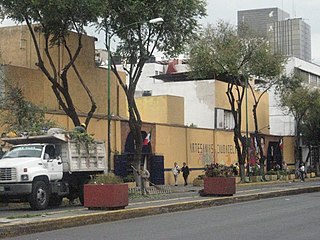
The Ciudadela Market is a traditional style Mexican market which specializes in the sale of Mexican handcrafts and folk art, located in the southwest corner of the historic center of Mexico City. The market is the first of its kind in the country, established just before the 1968 Summer Olympics to promote this aspect of Mexico's cultural heritage. It is home to over 350 vendors, mostly small operators selling to Mexican and foreign tourists.

Oaxaca handcrafts and folk art is one of Mexico's important regional traditions of its kind, distinguished by both its overall quality and variety. Producing goods for trade has been an important economic activity in the state, especially in the Central Valleys region since the pre-Hispanic era which the area laid on the trade route between central Mexico and Central America. In the colonial period, the Spanish introduced new raw materials, new techniques and products but the rise of industrially produced products lowered the demand for most handcrafts by the early 20th century. The introduction of highways in the middle part of the century brought tourism to the region and with it a new market for traditional handcrafts. Today, the state boasts the largest number of working artisans in Mexico, producing a wide range of products that continue to grow and evolve to meet changing tastes in the market.

Guanajuato handcrafts and folk art are mostly of European origin, although some indigenous work still survives in some communities. The most notable craft is the making of glazed mayolica pottery, followed by handmade traditional toys of various materials, especially a hard paper mache called cartonería. While handcrafts are not a large an industry here as in some other states, it does have several major handcraft markets which sell to tourists and foreign residents. Other handcraft traditions include wrought iron work, tin and glass, wood carving and leather working.

The Mexican State of Mexico produces various kinds of handcrafted items. While not as well documented as the work of other states, it does produce a number of notable items from the pottery of Metepec, the silverwork of the Mazahua people and various textiles including handwoven serapes and rebozos and knotted rugs. There are seventeen recognized handcraft traditions in the state, and include both those with pre Hispanic origins to those brought over by the Spanish after the Conquest. As the state industrializes and competition from cheaper goods increases, handcraft production has diminished. However, there are a number of efforts by state agencies to promote these traditions both inside and outside of Mexico.

Chiapas handcrafts and folk art is most represented with the making of pottery, textiles and amber products, though other crafts such as those working with wood, leather and stone are also important. The state is one of Mexico's main handcraft producers, with most artisans being indigenous women, who dominate the production of pottery and textiles. The making of handcrafts has become economically and socially important in the state, especially since the 1980s, with the rise of the tourist market and artisans’ cooperatives and other organizations. These items generally cannot compete with commercially made goods, but rather are sold for their cultural value, primarily in San Cristóbal de las Casas.

Puebla handcrafts and folk art is handcraft and folk art from the Mexican state of Puebla. The best-known craft of Puebla is Talavera pottery—which is the only mayolica style pottery continuously produced in Mexico since it was introduced in the early colonial period. Other notable handcraft traditions include trees of life from Izúcar de Matamoros and amate (bark) paper made by the very small town of San Pablito in the north of the state. The state also makes glass, Christmas tree ornaments, indigenous textiles, monumental clocks, baskets, and apple cider.

Jalisco handcrafts and folk art are noted among Mexican handcraft traditions. The state is one of the main producers of handcrafts, which are noted for quality. The main handcraft tradition is ceramics, which has produced a number of known ceramicists, including Jorge Wilmot, who introduced high fire work into the state. In addition to ceramics, the state also makes blown glass, textiles, wood furniture including the equipal chair, baskets, metal items, piteado and Huichol art.

Tlaxcala handcrafts and folk art is that which comes from the smallest state in Mexico, located in the center-east of the country. Its best-known wares are the "canes of Apizaco", sawdust carpets and the making of Saltillo-style serapes. However, there are other handcraft traditions, such as the making of pottery, including Talavera type wares, cartoneria, metalworking and stone working. The state supports artisans through the activities of the Fideicomiso Fondo de la Casa de las Artesanía de Tlaxcala
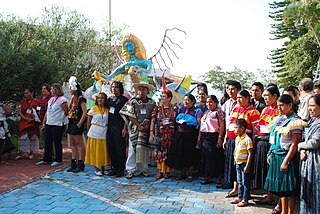
Feria Maestros del Arte is a non profit organization and annual three-day event held to support Mexican handcrafts and folk art in Chapala, Jalisco, Mexico. Unlike other fairs of this type, invited participants are not charged booth fees or percentages, and are even afforded transport and accommodations with area families. The Feria has grown from thirteen artisan participants to over eighty, and the organization is legally recognized in Mexico and the United States.
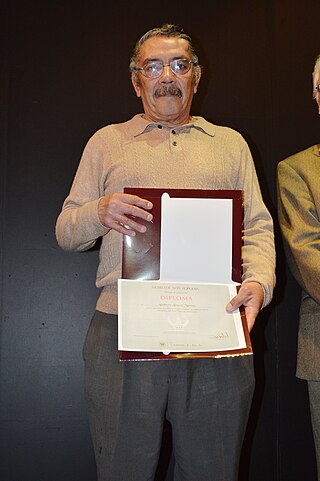
Adalberto Alvarez Marines is a Mexican artist and artisan who specializes in creating sculptures and other works in hard paper mache, called cartonería in Mexican Spanish. As a child, Alvarez began drawing and writing, with some success in publishing illustrations and stories. In his mid twenties, he discovered cartoneria and shifted his artistic work to this medium, first on a personal basis while working at a factory until in 1994, when he dedicated himself to the craft full-time. Alvarez's work is distinct in Mexican cartoneria because of its often non-traditional themes and artistic sense, often classed as art, rather than handcraft. With the exception of alebrijes and skeletal figures, Alvarez avoids traditional forms in favor of exploring what can be done with the medium, focusing on sculpture, decorative items and furniture. He was named a "grand master" of Mexican folk art in 2014 and has exhibited his work in Mexico and the United States. However, he does not like to spend time in exhibition and promotion, establishing his own Cartoneria Museum at his home in Santa Catarina Ayotzingo, Chalco, State of Mexico
